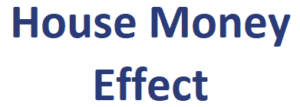House money effect
The house money effect refers to individuals’ tendency to treat some funds differently than other funds and taking excess risk with such money.
The effect is an emotional bias related to loss aversion that was first described by Thaler and Johnson in 1990 in a paper titled “Gambling With the House Money and Trying to Break Even: The Effects of Prior Outcomes on Risky Choice”, which was published in Management.
On this page, we discuss the effect in more detail and discuss how it is related to loss aversion.
House money effect definition
The house money effect refers to people’s tendency to treat money won differently than money earned in another way. In particular, investors are willing to take on greater risk when reinvesting winnings than they would when investing their savings or wages. Investors mentally segregate their initial capital investment and profits earned. The profits are seen as free money (house money), and the investor is willing to take more risk when reinvesting it.
Note that the house money effect is a form of mental accounting. Mental accounting refers to individuals’ tendency to treat money differently depending on how it is earned or what is spent on.
We should not confuse the effect with the investor practice of letting winners ride. Letting winners ride is a rational approach to investing that considers the fact that financial securities tend to exhibit momentum, i.e. the tendency for past winners to remain winners.
House money effect example
Let’s illustrate the effect using a simple example. Imagine we divide a large group of individuals into two groups. One group is told they have won $100 and could then choose to take part in a coin toss to gamble part of their winnings. Heads would reduce their winnings to $90 and tails would increase their winnings to $110. The second group is told that they can choose between receiving $100 or taking the coin toss with the same expected pay-off as for the first group.
The expected value for in both situations is the same, but the characteristics of the choices cause individuals to approach them differently. Individuals in the first group will tend to choose the gamble, while the second group will generally behave much more conservative.
Summary
We discussed the house level effect, which was first formulated by Thaler and Johnson in 1990.

